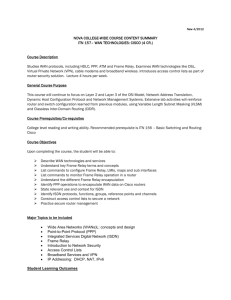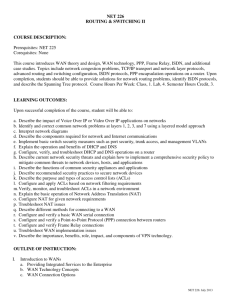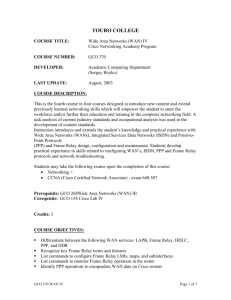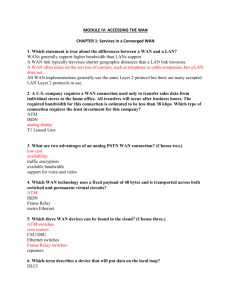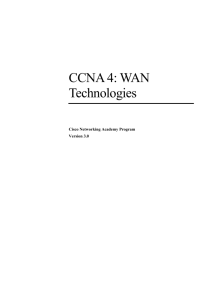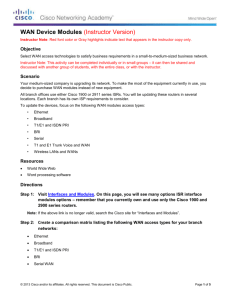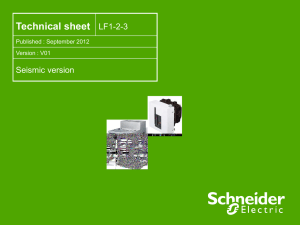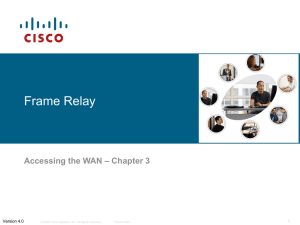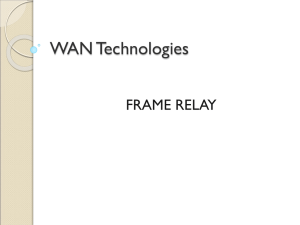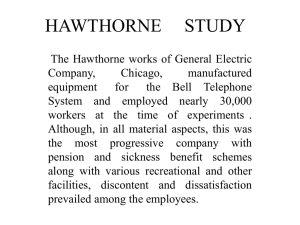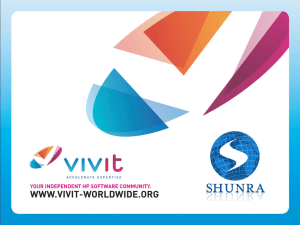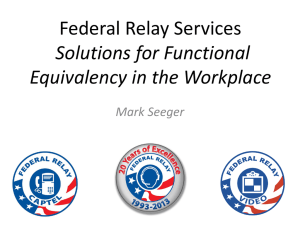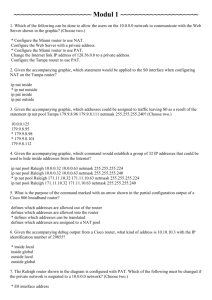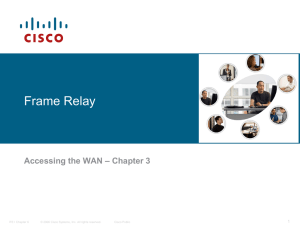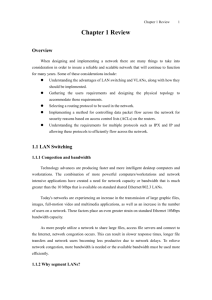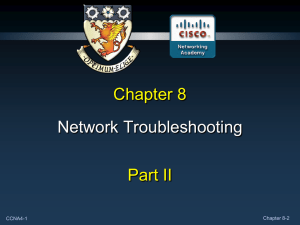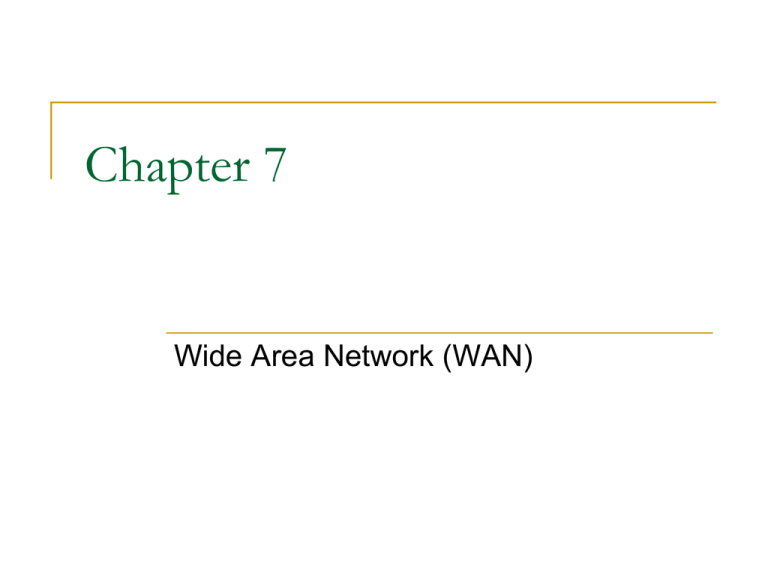
Chapter 7
Wide Area Network (WAN)
Outline
Overview
WAN Overview
Wan Connection Types
WAN Cabling
Layer 2 Encapsulation Protocols
Summary
3
WAN Overview
WANs connect remote sites.
Connection requirements vary depending on user
requirements, cost, and availability.
4
Interfacing Between
WAN Service Providers
•
Provider assigns connection parameters
to subscriber
5
WAN Connection Types: Layer 1
6
Circuit Switching
7
Packet Switching
8
Modem Transmission
11
Introduction to Serial Communication
Transmission system encodes bits into electrical
voltage using methods like NRZ-L or AMI
Some of the many serial communications
standards include the following:
RS-232-E
V.35
High-Speed Serial Interface (HSSI)
12
Time-Division Multiplexing
13
WAN Encapsulation
15
WAN Link Options
16
WAN Data-Link Protocols
18
Typical WAN Encapsulation Protocols:
Layer 2
19
Analog Dialup
20
ISDN
21
ISDN
Router with
standard serial
interface,
connected to a
terminal adapter
Router with native
ISDN BRI U or S/T
interface or PRI
22
Leased Line
Leased lines are not only used to provide direct
point-to-point connections between Enterprise LANS,
they can also be used to connect individual branches
to a packet switched network.
23
WAN with X.25
X.25 provides a low bit rate,
shared-variable capacity that
may either be switched or
permanent
24
Frame Relay
Most Frame Relay connections are based on PVCs rather
than SVCs.
It implements no error or flow control. This leads to reduced
latency.
Frame Relay provides permanent shared medium bandwidth
connectivity that carries both voice and data traffic.
25
ATM
Asynchronous Transfer Mode (ATM) is a technology
capable of transferring voice, video, and data
through private and public networks.
It is built on a cell based architecture rather than on
a frame-based architecture.
26
DSL
• DSL uses existing twisted-pair telephone lines to
transport high-bandwidth data
• DSL service is considered broadband, as it uses
multiple frequencies within the same physical
medium to transmit data
27
ADSL Technology
Splitter
• The local loop connects the splitter to the DSLAM
• DSLAM connected to ISP using ATM technology
• Voice and data use separate frequency ranges
(voice 0-4Khz, data 20Khx – 1Mhz)
28
Cable Modem
Enhanced Cable Modems enable two-way.
High speed data transmissions using the
same coaxial lines that transmit cable
television.
29
Modern WAN
30
WANs Operate at the Lower Three
Levels of the OSI Model
31
Comparing WAN Traffic Types
32
Establishing Serial Point-toPoint Connections
35
© 2004 Cisco Systems, Inc. All rights reserved.
ICND v2.2—5-35
HDLC Frame Format
• Uses a proprietary data field to support
multiprotocol environments
• Supports only single-protocol environments
38
An Overview of PPP
PPP
can carry packets from several protocol suites
using NCP.
PPP controls the setup of several link options using LCP.
39
PPP Layered Architecture
40
PPP and the Data Link Layer
41
PPP and the Network Layer
42
PPP Operation
43
Link Control Protocol Options
44
PPP LCP Configuration Options
45
Completing ISDN Calls
ISDN BRI and PRI
54
© 2004 Cisco Systems, Inc. All rights reserved.
ICND v2.2—7-54
What Is ISDN?
• Voice, data, video, and special services
56
ISDN Standards
Standards from the ITU-T
57
ISDN Access Options
58
ISDN 3-Layer Model
59
BRI and PRI Call Processing
60
ISDN Functions and Reference Points
Functions are devices or
hardware.
Reference points are
demarcations or interfaces.
61
ISDN Functions and Reference Points
62
Cisco ISDN BRI Interfaces
63
Cisco ISDN PRI Interfaces
64
Establishing Frame Relay
Connections
67
© 2004 Cisco Systems, Inc. All rights reserved.
ICND v2.2—6-67
Frame Relay Overview
Connections made by virtual circuits
Connection-oriented service
69
Frame Relay Stack
OSI Reference Model
Frame Relay
Application
Presentation
Session
Transport
Network
IP/IPX/AppleTalk, etc.
Data-Link
Frame Relay
Physical
EIA/TIA-232,
EIA/TIA-449, V.35,
X.21, EIA/TIA-530
70
Frame Relay Stack Layered Support
71
Local Significance of DLCIs
The data-link connection identifier (DLCI) is stored
in the Address field of every frame transmitted.
72
Frame Relay Terminology
73
Data Link Control Identifier
The 10-bit DLCI associates the frame with its virtual
circuit
It is of local significance only - a frame will not
generally be delivered with the same DLCI with which
it started
Some DLCI’s are reserved
74
Local Management Interface (LMI)
Three types of LMIs are supported by Cisco
routers:
Cisco — The original LMI extensions
Ansi — Corresponding to the ANSI standard
T1.617 Annex D
q933a — Corresponding to the ITU standard Q933
Annex A
75
Selecting a Frame Relay Topology
• Frame Relay default: nonbroadcast multiaccess (NBMA)
76
Frame Relay Address Mapping
Use LMI to get locally significant DLCI from the Frame Relay
switch.
Use Inverse ARP to map the local DLCI to the remote router
network layer address.
79
Frame Relay Signaling
Cisco supports three LMI standards:
Cisco
ANSI T1.617 Annex D
ITU-T Q.933 Annex A
80
Frame Relay Inverse ARP
and LMI Signaling
81
Stages of Inverse ARP
and LMI Operation
82
Q&A
Good luck everybody.

